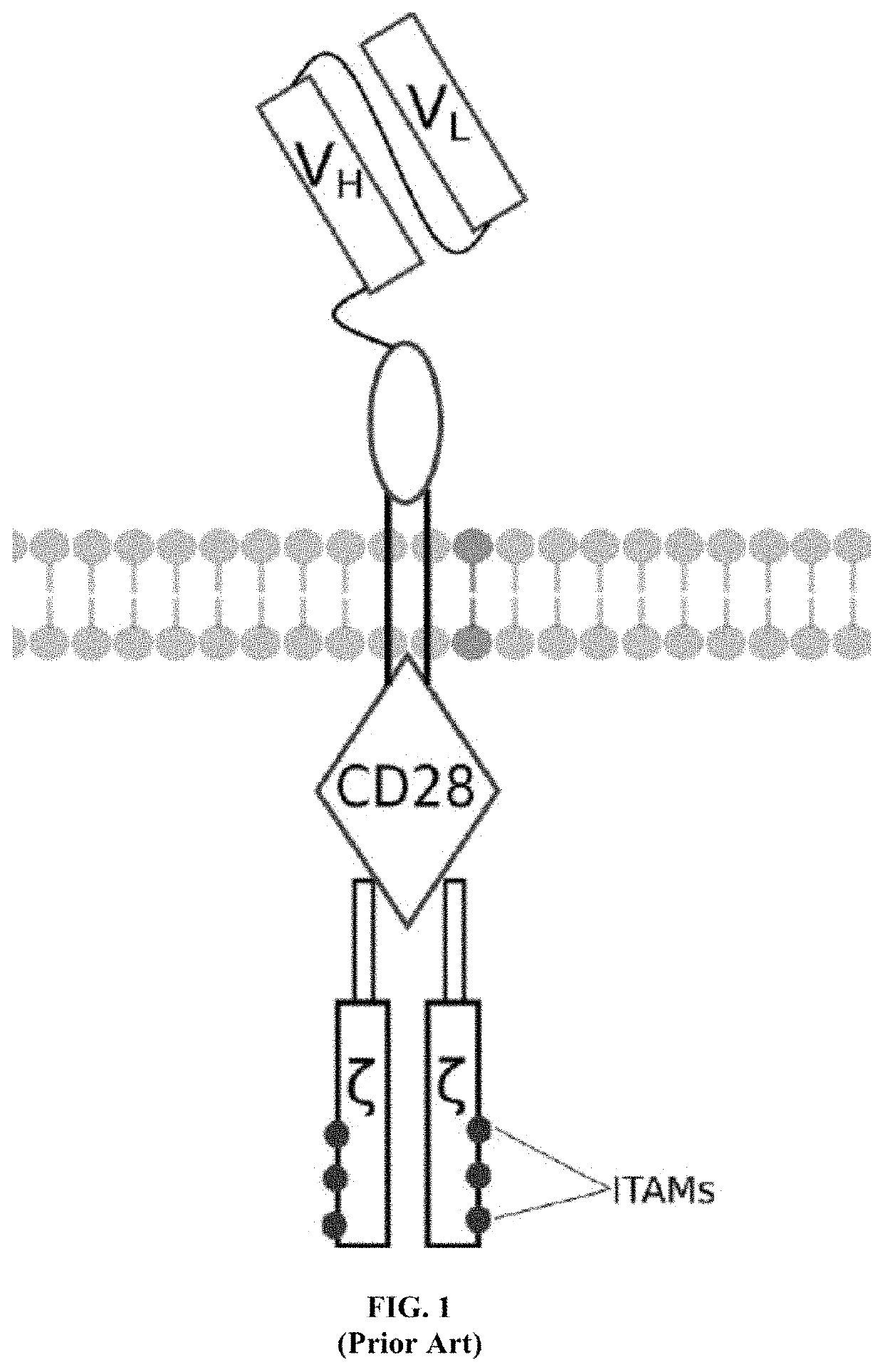Programmable immunocyte receptor complex system
a technology of immunocyte receptors and complexes, which is applied in the field of chimeric antigenic immunoreceptors, can solve the problems of tumor lysis, inability to control the rate of cytokine release, and typically lost episomal dna/rna
- Summary
- Abstract
- Description
- Claims
- Application Information
AI Technical Summary
Benefits of technology
Problems solved by technology
Method used
Image
Examples
example i
mFcγRI-CD3ζ
[0058]A first exemplary embodiment of the present invention includes a programmable, universal, adaptable TCR complex system that includes modification of the TCR complex by fusing mouse FcγRI (mFcγRI) to CD3ζ of the human TCR complex to generate mFcγRI-CD3ζ. The expressed universal receptor (mFcγRI) can bind to the Fc region of some mouse immunoglobulins with a high affinity and redirect the adaptor TCR complex cells to target specific antigens. FIG. 2 is an illustration of a mIgG antibody showing the antigen binding regions. The FcγRI-CD3ζ gene was delivered into CD4+ T cells by electroporation and added as a random insert. FIGS. 6-27 are illustrations of exemplary embodiments of the mFcγRI variant of the engineered receptors of the present invention, based either on the endogenous αβ T cell receptor complex or the endogenous γδ T cell receptor complex. A variant of this embodiment is further described in U.S. Pat. Nos. 9,752,199; 9,850,546; 9,850,547; and 9,850,548, wh...
example ii
mSA2-CD3ζ
[0059]A second exemplary embodiment of this invention includes a programmable, universal, adaptable TCR complex system that was developed through modification of the TCR complex by fusing monomeric streptavidin 2 (mSA2) and the endogenous CD3ζ of the human TCR complex. The mSA2-CD3ζ gene was introduced into CD4+ T cells as a heterozygous insert by replacing the endogenous CD3ζ using CRISPR / Cas9 technology through electroporation. In this design, the surface-expressed universal receptors (mSA2) can bind to any biotinylated target detector molecule (TDM) and redirect the adaptor TCR complex cells to target specific antigens. FIG. 3 is an illustration of an exemplary target detector molecule showing the paratope (or other ligand) for binding to target epitopes, the overall core structure for stability and biotin, the binding site for attaching to the engineered receptor. This version of the adaptor TCR complex differs from a standard CAR T cell in the following ways: (i) the m...
example iii
eMA-CD3ε
[0060]A third exemplary embodiment of this invention includes a programmable, universal, adaptable TCR complex system that was developed through modification of the TCR complex by fusing enhanced monoavidin (eMA) and the endogenous CD3ε of the human T cell receptor complex to form eMA-CD3ε (see FIGS. 46 and 48, which illustrates the design of the eMA-CD3ε adaptor TCR complex expression construct showing all 10 retained ITAMs). The universal receptor eMA can bind to any biotin-conjugated TDM with very high affinity, thereby enabling the modified T cells to target any antigen whose biotinylated TDM is loaded. In this embodiment, CD4+ T cells have been genetically engineered to express eMA-CD3ε on the cell surface. Following activation, the engineered CD4+ T cells recruit other immune cells to go after different cancer targets or pathogens. The eMA-CD3ε gene was introduced into T cells as a homozygous insert by replacing the endogenous CD3ε using CRISPR / Cas9 technology and by d...
PUM
| Property | Measurement | Unit |
|---|---|---|
| concentration | aaaaa | aaaaa |
| volume | aaaaa | aaaaa |
| concentration | aaaaa | aaaaa |
Abstract
Description
Claims
Application Information
 Login to View More
Login to View More - R&D
- Intellectual Property
- Life Sciences
- Materials
- Tech Scout
- Unparalleled Data Quality
- Higher Quality Content
- 60% Fewer Hallucinations
Browse by: Latest US Patents, China's latest patents, Technical Efficacy Thesaurus, Application Domain, Technology Topic, Popular Technical Reports.
© 2025 PatSnap. All rights reserved.Legal|Privacy policy|Modern Slavery Act Transparency Statement|Sitemap|About US| Contact US: help@patsnap.com



